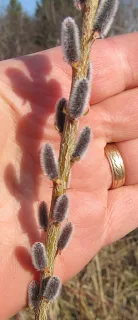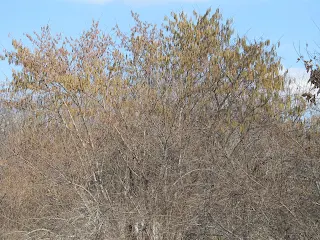This is sort of a "before" picture. I had been cutting and pulling for a bit before I figured out this might be a good picture to have.
Dragging brush entails cutting the chunks into a size I can handle without blowing out my back. Thirty to fifty pounds is a decent size. Trimming off the twigs and the bushy-brush leaving the chunks.
The bigger pieces of apple wood are going to a restaurant to smoke meat. They are fussy about having no poison ivy on the wood. I made sure the wood was clean.
I got most of it into the back of the truck but it squatted her down a bit.
The trimmings went into the swamp.
Plenty of time to look at trees. This is a Golden Delicious truck with winter damage on the north side.
Dragging brush, I am lichen it. Moss and lichens are evidence that the trees are in a low state of nutrition. The trees usually add enough girth that the lichens slough off. These trees, obviously, need more fertilizer.
This tree could be a metaphor for the economy. The stem on the left is old. It has too many branches, too much dead wood and there is way too much competition within the canopy for the sunlight that falls upon it. Much of the wood has been bend downward by the weight of the fruit. It tries to set too much fruit and consequently goes into a boom-bust cycle of biennial bearing. The stem on the right is younger and is carrying an appropriate amount of "wood" and fruiting spurs for the incident sunlight.
I will knock the snot out of the older stem on the left and I will guide the stem on the right away from the older stem by pruning it to bias it to the right. That will diminish the competition between the two stems and the newer stem will be harvesting "incremental" light.
I took a few breaks.
There is hazelnut growing in the windbreak around the orchard. It is blooming. This is a "girl" flower and will turn into a cluster of nuts if pollinated.
These are hazelnut catkins. They are the "boy" flowers and supply the pollen need for the girls.
Vernal Witchhazel is not a very flashy plant but it smells FABULOUS. It blooms very early in the spring. It is not a native of Michigan.
 |
| You can click to embiggen. It amazes me how soft and fine the hairs (anthers) are on these pussy willows. |
 |
| No pollen is visible yet. But soon.... |
Beekeepers like male willows that bloom early. Willow pollen is sticky enough for bees to collect it, unlike the pollen of Red and Silver Maple and aspen. Those species are wind pollinated and it is a chore for bees to collect the pollen. Early blooming plants are useful for building up bee hive populations just ahead of the big spring push. It takes about 30 days from packing the cell with food to a worker bee on-the-wing. Apple trees generally start blossoming here the second week of May.
If all goes well, I will be dragging brush again today.













No comments:
Post a Comment
Readers who are willing to comment make this a better blog. Civil dialog is a valuable thing.